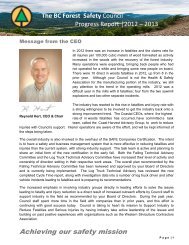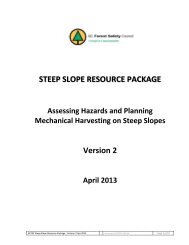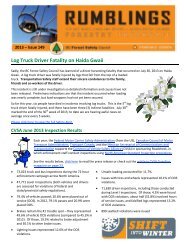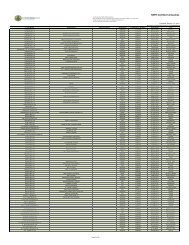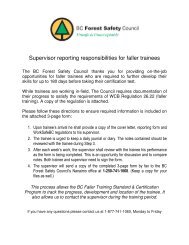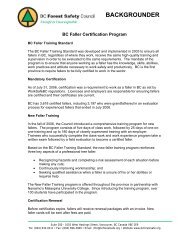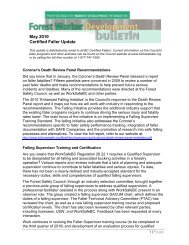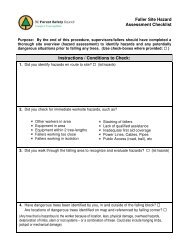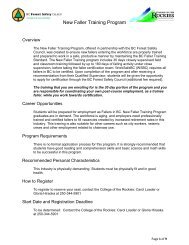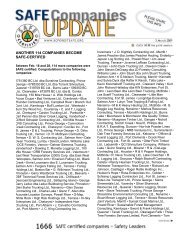Log Hauling & Lowbedding Safe Driving Practices And Operating ...
Log Hauling & Lowbedding Safe Driving Practices And Operating ...
Log Hauling & Lowbedding Safe Driving Practices And Operating ...
You also want an ePaper? Increase the reach of your titles
YUMPU automatically turns print PDFs into web optimized ePapers that Google loves.
On-Block Procedures<br />
(Revised October 2006)<br />
Use only the posted radio frequency for the block.<br />
Drivers must remain either in the cab of the vehicle or stand 13m in front of the truck<br />
in clear view of the loader operator at all times while the truck is being loaded. Notify<br />
the loader operator before leaving the truck and upon returning into the truck.<br />
After loading is completed, a loaded log haul truck may be moved a short distance (up to<br />
500 m) without wrappers or binders, provided that no workers are endangered, and there<br />
is a minimal chance the load will shift (i.e.: Do not travel up or down steep grades or on<br />
rough roads).<br />
Cell Phone Use<br />
Cellular telephones have been common and invaluable in forestry operations. Insurance<br />
Corporation of British Columbia (ICBC) studies have found that listening and responding to<br />
relatively complex messages while continuing to drive, significantly degrades driving<br />
performance, especially during complex driving maneuvers.<br />
On Canfor radio controlled roads, drivers’ attention should be focused on following the<br />
traffic using both the radio and visual signs to ensure safe use of the road. Canfor strongly<br />
suggests all drivers to reduce the risk of accidents, incidents and near misses by pulling<br />
into the first available turnout to complete calling activities using cellular phones. Continue<br />
to monitor traffic on the road.<br />
Procedures for Blocking /Re-routing Traffic<br />
It is imperative that signs and traffic controls are in place during the cleaning of all spilled<br />
loads or any abnormal activity that may block Canfor roads. All signs and traffic controllers<br />
must be in clear view and away from any blind hills and corners that may be hazardous.<br />
RADIO USAGE<br />
Breakdown in radio communications is a leading cause of accidents, so please use<br />
your radio appropriately. Mistakes are made, so be alert, always drive defensively.<br />
Radio frequency usage is coordinated by Canadian Forest Products Ltd. Always<br />
remember that roads are open to the general public and periodically, vehicles without<br />
radio's get onto our road system. Drive by the road, not by the radio alone.<br />
If your radio fails to transmit, stop and arrange to follow another driver, with him calling for<br />
your vehicle.<br />
A copy of the radio channels and road frequency map should be carried and be readily<br />
available. An updated list of radio frequencies used for Canfor operations is distributed at<br />
the beginning of each logging season.<br />
11



